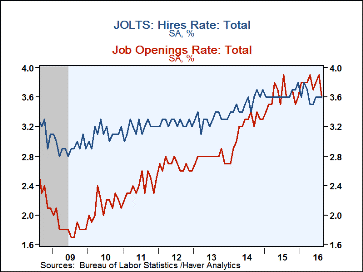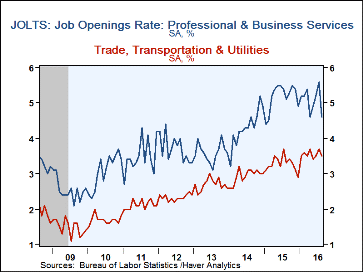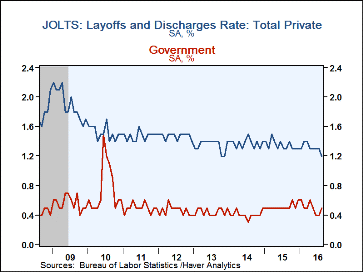 Global| Oct 12 2016
Global| Oct 12 2016U.S. JOLTS: The Labor Market Cools Off
by:Tom Moeller
|in:Economy in Brief
Summary
The total job openings rate declined to 3.6% in August, down from the record high of 3.9% in July. It was the lowest rate since December. The private sector job openings rate fell to 3.9%, a three month low. In the government sector, [...]
The total job openings rate declined to 3.6% in August, down from the record high of 3.9% in July. It was the lowest rate since December. The private sector job openings rate fell to 3.9%, a three month low. In the government sector, the job openings rate eased to 2.2%, the lowest point since March. The Bureau of Labor Statistics reports these figures in its Job Openings & Labor Turnover Survey (JOLTS).
The job opening rate declined in most major sectors except for leisure & hospitality where it rose to a three-month high of 4.7%. In professional & business services a precipitous drop to 4.6% from 5.6% was registered. Another large decline in the openings rate was seen in construction to 2.7% from 3.3%, and the factory sector's 2.7% was down from 3.0%. The trade, transportation & utility rate fell to 3.5% from its cycle high of 3.7%, and the openings rate in education & health services eased to 4.4%, the lowest point since March. The job openings rate is the number of job openings on the last business day of the month as a percent of total employment plus job openings.
The actual number of job openings declined 6.7% (+2.5% y/y) to 5.443 million following a 3.3% rise in July. Private-sector openings were off 6.6% (+2.3% y/y) to 4.936 million, the lowest level this year. Construction job openings increased 21.9% y/y while the number of leisure & hospitality openings grew 7.5% y/y. Factory sector openings increased 5.0% y/y, and they improved 2.7% y/y in education & health services. To the downside by 6.2% y/y were openings in professional & business services. Government sector job openings increased 5.0% y/y to 507,000.
The total hires rate was unchanged at 3.6% for the third straight month, below February's of 3.8%. The private sector rate was steady at 4.0%, but remained below 4.2% it reached in February. The hiring rate in leisure & hospitality topped the chart with a stable 6.4% rate. The hiring rate in professional and business services eased to 5.3%, but in construction it rose to 5.1%. A 4.6% rate in retail trade compared to 2.7% in education & health services. The government sector hiring rate was stable m/m at 1.7%, but it has been rising steadily from 1.0% early in 2011. The hires rate is the number of hires during the month divided by employment. The total hires rate in the government sector edged up to 1.7% from 1.6% in June.
The number of hires declined 0.9% (+3.0% y/y) to 5.210 million in August. The decline was the first in three months. Private sector hiring fell 1.1% (+2.8% y/y). A 7.7% decline was registered in professional & business services, but jobs rose 10.4% y/y. Retail trade experienced a roughly 2.0% decline both m/m and y/y. Education, as well as leisure & hospitality, experienced little change both m/m and y/y. Government sector hiring increased 1.4% (5.1% y/y).
The total job separations rate eased to 3.4%, down from its cycle high of 3.6% in February. The actual number of separations fell 0.7% m/m (+0.1% y/y) to 4.954 million. Retail trade separations declined 7.2% y/y while leisure & hospitality separations dropped 1.1% y/y. To the upside, professional and business services exhibited the largest percentage gain in separations of 8.2% y/y while separations in the education and health services sector increased 5.9% y/y. Government separations increased 4.6% y/y. Separations include quits, layoffs, discharges, and other separations as well as retirements.
The layoff and discharge rate remained at its record low of 1.1% in August. The private sector rate slipped to 1.2% from 1.3% in July, while the government rate ticked up to 0.5%. Total layoffs declined 4.1% y/y. Private-sector layoffs fell 5.4% y/y, but government layoffs rose 13.3% y/y.
Large numbers of hires and separations occur every month throughout the business cycle. Net employment change results from the relationship between hires and separations. When the number of hires exceeds the number of separations, employment rises, even if the hires level is steady or declining. Conversely, when the number of hires is less than the number of separations, employment declines, even if the hires level is steady or rising. Over the 12 months ending in July, hires totaled 62.5 million and separations totaled 60.0 million, yielding a net employment gain of 2.5 million. These totals include workers who may have been hired and separated more than once during the year.
The JOLTS survey dates to December 2000 and the figures are available in Haver's USECON database.
Acknowledging Uncertainty by Cleveland Fed President Loretta J. Mester is available here.
| JOLTS (Job Openings & Labor Turnover Survey, SA) | Aug | Jul | Jun | Aug '15 | 2015 | 2014 | 2013 |
|---|---|---|---|---|---|---|---|
| Job Openings, Total | |||||||
| Rate (%) | 3.6 | 3.9 | 3.8 | 3.6 | 3.6 | 3.3 | 2.7 |
| Total (000s) | 5,443 | 5,831 | 5,643 | 2.5% | 9.7% | 28.7% | 4.6% |
| Hires, Total | |||||||
| Rate (%) | 3.6 | 3.6 | 3.6 | 3.6 | 43.6 | 42.2 | 39.6 |
| Total (000s) | 5,210 | 5,258 | 5,172 | 3.0% | 5.2% | 8.2% | 3.5% |
| Layoffs & Discharges, Total | |||||||
| Rate (%) | 1.1 | 1.1 | 1.1 | 1.2 | 14.9 | 14.7 | 14.7 |
| Total (000s) | 1,623 | 1,639 | 1,622 | -4.1% | 2.7% | 2.4% | -5.3% |
Tom Moeller
AuthorMore in Author Profile »Prior to joining Haver Analytics in 2000, Mr. Moeller worked as the Economist at Chancellor Capital Management from 1985 to 1999. There, he developed comprehensive economic forecasts and interpreted economic data for equity and fixed income portfolio managers. Also at Chancellor, Mr. Moeller worked as an equity analyst and was responsible for researching and rating companies in the economically sensitive automobile and housing industries for investment in Chancellor’s equity portfolio. Prior to joining Chancellor, Mr. Moeller was an Economist at Citibank from 1979 to 1984. He also analyzed pricing behavior in the metals industry for the Council on Wage and Price Stability in Washington, D.C. In 1999, Mr. Moeller received the award for most accurate forecast from the Forecasters' Club of New York. From 1990 to 1992 he was President of the New York Association for Business Economists. Mr. Moeller earned an M.B.A. in Finance from Fordham University, where he graduated in 1987. He holds a Bachelor of Arts in Economics from George Washington University.










